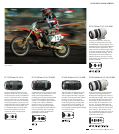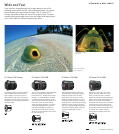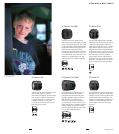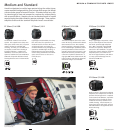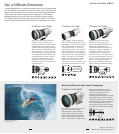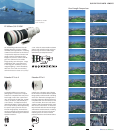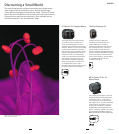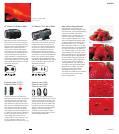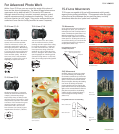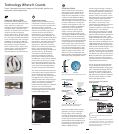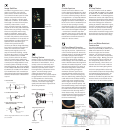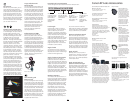
TS-E LENSES
33
●
Aspherical lens
For Advanced Photo Work
With a Canon TS-E lens, you can control the angle of the plane of
focus and the picture’s perspective. The effects of large-format camera
movements can be obtained with TS-E lenses for EOS cameras.
Although manual focusing is required, automatic aperture control
enables autoexposure and autoexposure bracketing. The tilt and
shift axes intersect at a 90˚ angle. They can be made parallel at an
authorized Canon Service Facility (modified at owner’s expense).
32
TS-E 24mm f/3.5L
The widest tilt-shift lens in the Canon
system, and a marvelous problem-
solver for architecture, scenics, and
many other applications calling for a
wide-angle perspective. With floating
optics, it’s sharp from infinitydown to
1 ft. (0.3m), and it uses a ground and
polished Aspherical frontelement to
assure excellent quality. Like all the
TS-E lenses, it has a fully automatic
diaphragm, so there’s never a riskof
forgetting to stop the lens down.
TS-E 45mm f/2.8
The normal lensin the TS-E system,
and an excellent choice for product
shooting and other applicationscalling
for a natural perspective. Itallows up
to 11mm of shift off-center, and even
more impressive, tilting of the front
standard up to 8° to modify the plane
of focus. Among the TS-E 45mm f/2.8’s
optical highlightsare a floating optical
system (focusing down to 1.3 ft/0.4m),
and a precise rear-group focusing system.
TS-E 90mm f/2.8
Telephoto perspective, f/2.8 speed,
and full tilt and shift movements in a
compact, professional package.
Impressively sharp, itsability to alter
the plane of focus can provide a “look”
that previouslyrequired a view camera
to achieve. Pros have found ita great
option for portraits, products and
even fashion work. At itsclosest
focus distance (1.6 ft/0.5m), it gives
magnificationsof about 1/3 life-size.
TS-E45mm f/2.8
•f/4 •1/30 sec.
TS-E Lens Movements
TS-E lenses are capable of tilt and shift movements which greatly
expand picture-taking possibilities. Tilt movements alter the angle
of the plane of focus between the lens and film plane, and shift
movements move the lens’ optical axis in parallel.
Tilt Movements
If you want to bring the entire length of
the hedge into focus, you could use a
wide-angle lens and a small aperture to
obtain a wide depth of field (Photo 1-a).
With tilt movements, you can achieve
this wide depth of field even at the max-
imum aperture. Bytilting the center of
the TS-E lens barrel, you can tiltthe lens
so that the plane of focusis uniform on
the film plane (Photo 1-b).
Depth of field with tilt movements
Plane of optimum focus
Film plane
Using Tilt Movement to Focus
an Oblique Subject Plane
Shift Movements
Normally, when you point yourcamera
up at a tall building, the building will
look slimmertoward the top. It becomes
trapezoidal (Photo 2-a). This perspective
effect is more pronounced with shorter
lens focal lengths, distorting the building
even more. By altering the parallel
position between the lens and the film
plane with the TS-E lens, this perspective
effect can be corrected. With the camera’s
film plane set parallel to the building,
shifting the lens upward will obtain a
more rectangular-looking building
(Photo 2-b).
Photo 1-a
Uncorrected
Photo 1-b
Corrected with tilt
Photo 2-a
Uncorrected
Photo 2-b
Corrected with
shift
Using Shift Movements to Focus Tall Building
With a normal lens
With a TS-El lens



